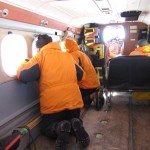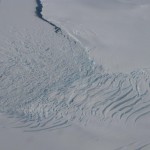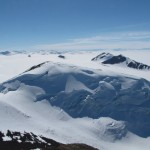Saturday 1st December
After a final difficult day striking camp and manhauling everything out to the new depot and skiway on Friday, we were airlifted out and moved to Fossil Bluff, where there is a small hut and a fuel depot. We joined Andy and Rob, who are responsible for maintaining the hut (Bluebell Cottage) and skiway and for refuelling the planes that pass through to field parties all over the pace. Although Bluebell Cottage is very basic, it is luxury compared with the last month. It is warm and there are beds, and it is good to have a table and chairs again!
We have decided that we are all owed a little bit of luxury, so we spent the morning relaxing and washing (clean hair! Again!) and then did a half day of fieldwork on the moraines around basecamp. We have again found granite boulders from Palmer Land at about 82 m, but are unsure as to their geomorphological situation. They seem to be reworked in the valley glacier moraines.

The valley glacier moraines are very steep and ice-cored, with plenty of angular mudstone rocks derived from the scree slopes above. The glaciers here are again down-wasting the thinning, with evidence of substantial thinning since their large, prominent ice-cored moraines were formed. The angularity of the glacial material and lack of fine-grained sediment (such as silt or clay) is typical of cold-based glaciers, which move only slowly and have not reached pressure melting point.
Sunday 2nd December
A fantastic day. One of the reasons I became a glaciologist. We did a big walk up the corrie to the peak, around the back of the corrie, and then down the screes home, sampling and mapping on the way. This meant climbing up a snow-filled gully (I always like it when I get to use my ice axe and crampons), scrambling up scree and rock (I never like this), and then my new favourite sport – scree running all the way home. The views from the top were amazing. The ice is so pure and white, it looks like a soft, flawless blanket gently draped over the landscape. Who could guess at the erosive power of the processes operating underneath? It all seems so peaceful. We all spent a moment at the summit, simply absorbing the view.
The area around here seems to have been much more heavily influenced by the Alexander Island Ice Cap, and we have found no evidence of incursions of ice from Palmer Land (i.e. none of these tell-tale granite boulders). We are also much higher – Bluebell Cottage is at 66 metres compared with 7.5 at our previous base camp. There seems to be no evidence of ice-shelf moraines here, granite-bearing or otherwise.
Monday 3rd December
Our final science day! We walked to Belemnite Valley. As the name suggests there were plenty of fossils to be found. We spent the day observing the moraines – they seem contemporaneous with the moraines in Khufu Corrie, where Bluebell Cottage is located. However, they are much closer to the modern snout, and the glacier appears to have been much smaller than in Khufu Corrie. The moraines lie on top of a sheet of an older glacial drift, which we also sampled. It is possible that this corrie has been ice-free for quite some time. These ages will be interesting to compare with Ablation, where I think the story will be quite different. Rather than the Alexander Island Ice Cap being a large, dominant feature during the last ice age, it is possible that it was quite complex, and variable rates of ice recession, dependent on the availablity of snow. We will need to wait 18 months for the ages to come back so we can find out.
We were back at camp by 4 pm, having enjoyed our ‘decompression’ and slow re-entry towards the land of real food, hot showers and unlimited water. We hope to be uplifted tomorrow.




























